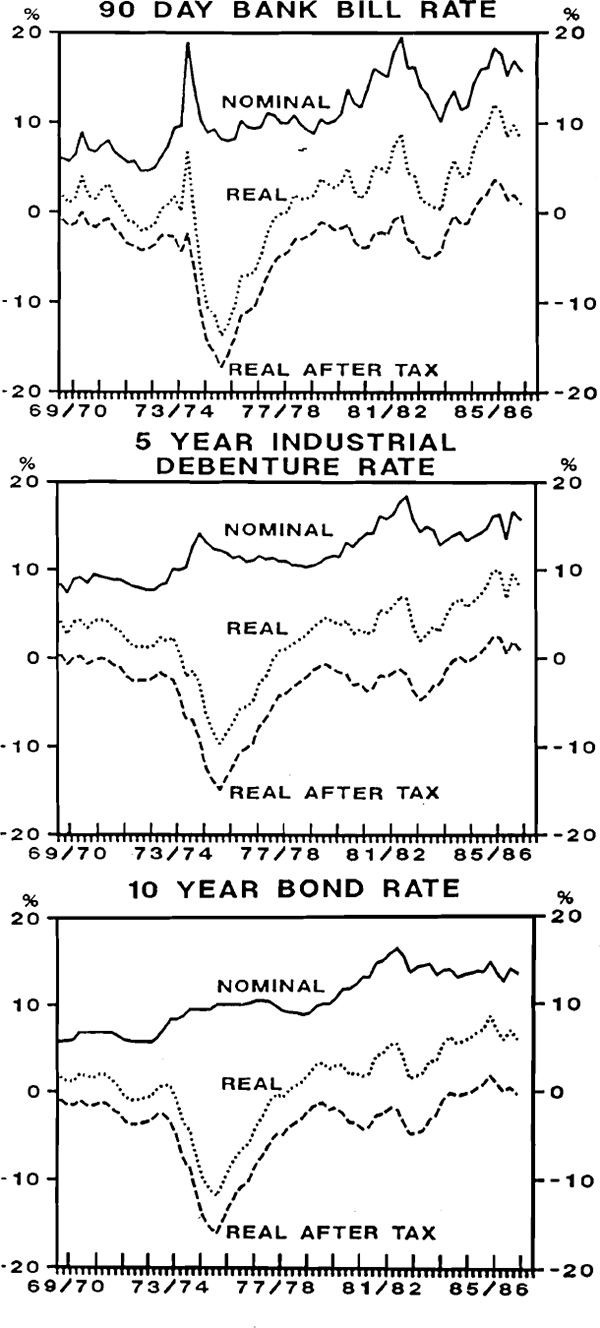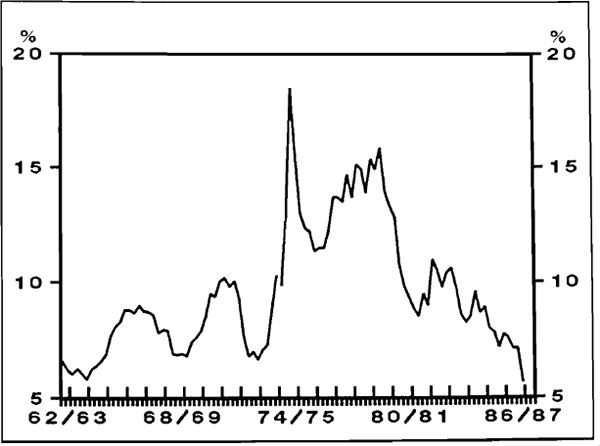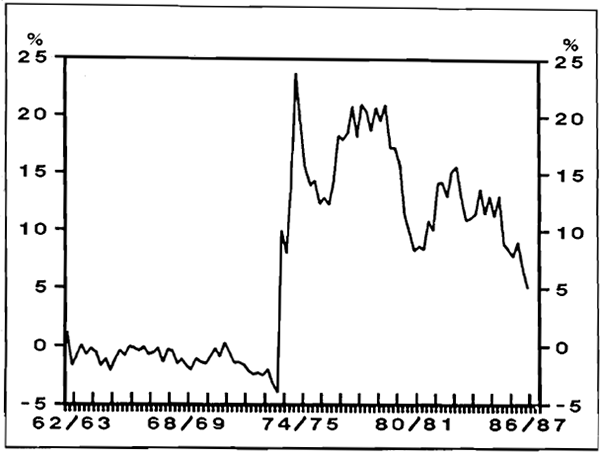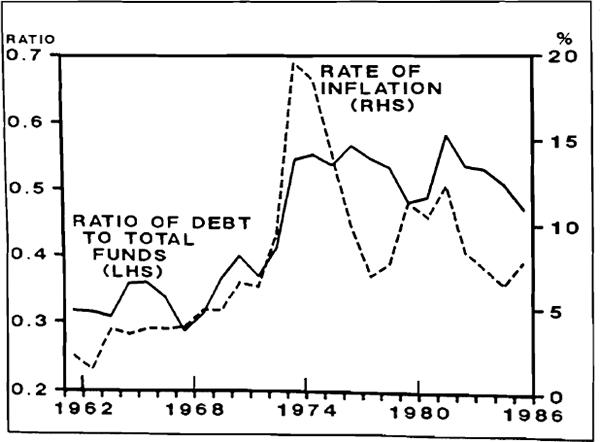RDP 8807: The Cost of Capital: Some Issues 3. Trends in the Cost of Debt and Equity
August 1988
- Download the Paper 803KB
The relative importance of debt and equity as financing tools and recent trends in each are discussed in this section. This highlights the need to take the cost of both into account when attempting to determine the cost of capital.
a. The Cost of Debt
There is no one interest rate, either nominal or real, which is relevant to all firms' decisions to invest. Figure 3.1 shows three potentially relevant interest rates in both nominal and real terms, and real terms after tax considerations have been taken into account. It appears that shorter term rates are the most volatile.

By historical standards, nominal interest rates in Australia have been high during the 1980s. Although this can partly be explained by inflation, interest rates have generally also increased in real terms, at least until recently. Other common features evident from figure 3.1 are:
- nominal interest rates surged in the mid 1970s, due to large budget deficits, tight liquidity conditions and expectations of high rates of inflation. Subsequently conditions eased markedly and nominal interest rates were more stable until the end of the decade. In 1981–82 interest rates rose to record levels, when, despite the slowing in economic activity, the overall demand for funds remained high. After declining for a short period in 1982–83, rates rose once more during the mid 1980's. Recently, there have been some falls;
- real interest rates reveal a somewhat different pattern. After a period of relative stability in the early 1970s, they declined rapidly in the mid 1970s then rose fairly steadily until the early 1980's. Real rates appear to have peaked during 1985–86;
- real after-tax interest rates appear to have risen by substantially less than pre-tax rates since the early 1970s. Unlike both nominal and real rates, real after-tax interest rates were at similar levels to those evident in the early 1970s through most of the first half of the 1980s. Real rates also appear to have increased in more recent times, although not to the same extent as other rates. The real post-tax interest rate on 10-year bonds, for example, is not substantially greater than its average level during the 1960s.
Interest rates relevant to an investment decision vary according to a number of factors including, the particular borrowing requirements of each firm and its susceptibility to risk. Borrowers face different rates depending on their credit worthiness, the purpose of borrowing and the length of repayment. Tax considerations are also important.
There are many channels through which interest rates may influence investment. These include cash flow considerations, opportunity cost, risk and the cost of capital. Different types of interest rates are relevant depending on the channel being discussed. For example, nominal interest rates are probably most relevant for short term cash flow considerations. Sustained real interest rate changes are more relevant for the cost of capital “hurdle” with which real rates of return from an investment are compared, because, other things being equal, an increase in inflation lowers the cost of borrowing for the firm.
In theory, a real interest rate represents the terms on which current consumption can be exchanged for future consumption. An investor gives up current consumption and acquires a claim to a stream of (risky) future payments with which to purchase future consumption. These payments must be adjusted to take account of expected inflation which affects the present value of any future income stream. Other things being equal, the less the future purchasing power of the prospective payments, the lower the cost to the firm.
Measuring real interest rates, however, involves many uncertainties as various measures of inflation are available. Since borrowing decisions are forward looking, nominal interest rates should be adjusted for expected inflation rather than the current rate of inflation. Since expectations are not directly observable, it is common practice to use a measure of past inflation.[4]
Tax considerations also need to be taken into account. It is increases in the after-tax real rate of interest that raise the cost of borrowing to finance investment since nominal interest expenses are generally tax deductable for borrowers (provided they are profitable). This cost is, in turn, affected by changes in tax arrangements for firms and the distortions created by the interaction between inflation and taxation.
The term to maturity of the interest rate is also important. Since an investment decision is generally a long-term one, borrowers may have a preference to borrow at a fixed rate over a long period of time. For this reason, the cost of capital measure constructed in this paper contains a five year debenture rate. However, the deregulation of financial markets in combination with increased nominal interest rates may have altered the importance of longer term interest rates. This point is discussed further in section 5.
b. The Cost of Equity
The cost of debt is only part of the story of the cost of capital. The perhaps less-often discussed side is the cost of equity finance. From the firm's point of view, the earnings yield (or earnings to price ratio) represents the cost of raising equity finance. Substantial increases in stock prices over recent years and subsequently low earnings yields for equities suggest, at face value, that the cost of equity has been relatively low by historical standards.
Earnings yields for equities from December 1962 to March 1987 are shown in figure 3.2. Data prior to 1974 are the average earnings yield of “50 leaders” from the Melbourne Stock Exchange. This is not strictly comparable with the average earnings yield for “all ordinaries” companies (weighted by market capitalisation) shown for the later period.

The earnings yield remained at less than 10 per cent through most of the 1960s and did not fluctuate by more than 5 percentage points throughout the period. In the mid 1970s, however, the average earnings yield rose quite dramatically, and then fell sharply. Yields then rose fairly steadily to the end of the decade. Despite some short periods of increasing yields, during the remainder of the period earnings yields were substantially reduced.
This reduction in yield throughout most of the 1980s reflects the buoyancy of Australian share markets. From December 1980 to March 1987 the all ordinaries index of Australian share prices had risen by nearly 250 per cent.
In general, when share prices are expected to rise shareholders will be expecting returns to rise, because the return to the shareholder includes the nominal capital gain on shares (which until recently, often went untaxed) – not just dividends received. The nominal cost to the firm is the earnings yield which, other things being equal, will fall as prices rise. Thus, during periods of rising prices this divergence may make it relatively easy for firms to raise funds on equity markets.
However, it is the expected real rate of return on equity – not the nominal earnings yield – which is the relevant cost of capital “hurdle” in any investment decision. This is because the expected real rate is the discount rate required to equilibriate the market value of equity in the current period (its present value) with expected future earnings, net of operating expenses and taxes. Among other things not included in the earnings yield, this takes into account risk and opportunity cost for equity holders.
Figure 3.3 shows such a theoretical real rate of return on equity calculated using a combination of stock market and national accounts data. It has been derived on the basis of the theory of the valuation of the firm. The methodology follows that outlined in appendix II, consistent with Carmichael and Stebbing (1981).

It takes into account tax considerations for the firm and the impact of the interaction of inflation and taxation on real earnings yields. In particular, an adjustment is made for loss of real income due to the difference between the value of the depreciation allowance permitted by tax law (based on historical cost, and eroded by inflation) and the true economic rate of depreciation.
Movements in this series have been quite different from those shown for the various measures of real after-tax cost of debt shown in figure 3.1. In fact, the pattern of movements is almost the inverse of that shown by real interest rates since the mid 1970s, although earnings yields appear to be more volatile.
The expected real rate of return on equity remained fairly flat until the early 1970s. It rose sharply, however, during the mid 1970s, with the surge in inflation at that time. Although falling a little in the period immediately following, it had returned to near record levels by the late 1970s and remained fairly constant for a few years. During the early 1980s, the rate of return fell, although the falls were short lived. However, since 1983 there has been a fairly steady decline in the rate of return on equity. It appears to be much lower than at any time since the early 1970s although it has still not returned to the levels of the early 1960s.
In many respects of the real cost of equity appears to reflect movements in the average earnings yield, which enters the calculation after tax considerations are taken into account. However, there are a number of important differences. The real rate of return on equity was more stable during the 1960s, and appears to have been more volatile during the second half of the 1970s and early 1980s. The oil price shock, and subsequent inflationary process during the 1970s also appear to have caused real earnings to increase much more substantially than nominal earnings. Also, in recent years, the nominal earnings yield appears to have fallen to levels lower than experienced during the 1960s, while the real rate of return is still a good deal higher.
c. The Debt-Equity Mix
Financial markets generally have fewer imperfections than other markets. Jonson and Rankin (1986) suggest that innovation and deregulation have reduced these imperfections still further. For this reason, it could be expected that the cost of raising capital using debt or equity markets might be similar. However, regulatory changes and the interaction between inflation and taxation tend to alter the preferred debt-equity ratio of firms.
Although a firm can vary its mix of debt and equity there are costs to adjustment and such adjustment takes time. Decisions regarding the method of raising funds also depend on a number of other factors apart from relative cost. These include:
- funding techniques available;
- use to which funds raised are to be put;
- the size, maturity and timing of an issue;
- the need to maintain a presence in the market;
- profit expectations;
- risk preferences of investors; and
- changes in the underlying industrial structure.
The real rate of return to debt and equity will be altered by a change in the rate of inflation, since nominal interest income from an investment is taxed and nominal interest costs can be deducted from taxable income. Given the lower after-tax cost to the firm of debt finance, it is not surprising that firms have tended to issue debt rather than equity as the rate of inflation increases.
Because the interest rate and the equity yield that a firm must pay are an increasing function of its debt equity ratio, the firm can choose an optimal ratio that minimises its total cost of capital. However, companies also have gearing ratios to comply with, and the procedures to reduce equity capital for a public company may involve delays and substantial costs. Funds may, thus, be “locked up” in some sense.
One theoretical view is that the cost of debt and equity finance rises with the debt-equity ratio in such a way that a unique cost minimising ratio is maintained. Modigliani and Miller (1958) put an alternative view that, in the absence of distortions, taxes and default risk, both firms and individuals will be indifferent to the financial mix. Myers (1977) showed that an optimal debt-equity ratio is one that trades off the tax advantages of debt and the costs of a suboptimal future investment strategy induced by debt.[5]
Figure 3.4 shows the debt to total funds (debt plus equity) ratio for a sample of 50–60 companies listed on the Sydney Stock exchange. The data suggest that the equilibrium debt-equity ratio rose with inflation in the early 1970s and again in the early 1980s. This relationship does not appear to hold so clearly in the second half of the 1970s when inflation fell, but levels of outstanding debt remained high. It appears that the level of debt accumulated may be “sticky downwards”, with respect to inflation – at least to some extent.

In recent years, debt has become a smaller part of total funds raised by the sample of firms, despite some pick-up in inflation. This may be associated with the currently high cost of debt relative to equity and firms' perceptions of future inflation (for example, firms may expect the current rise in the inflation rate to be only temporary). It may also reflect preparation for the introduction of the new corporate tax system which reduces the incentive to adopt high gearing ratios.
Footnotes
The measure of expected inflation used in real interest rate calculations in this paper is the average change in the non-farm GDP deflator, over the previous four periods (not including the current period). This is consistent with the approach taken by Atkinson and Chouraqui (1985). The advantage of this method is its simplicity. Alternative approaches involve the use of rational or adaptive expectation models. For a fuller discussion of various forms of interest rates see Atkinson and Chouraqui (1985). [4]
For a thorough survey of the literature covering the theoretical issues, see Carmichael and Stebbing (1981). [5]